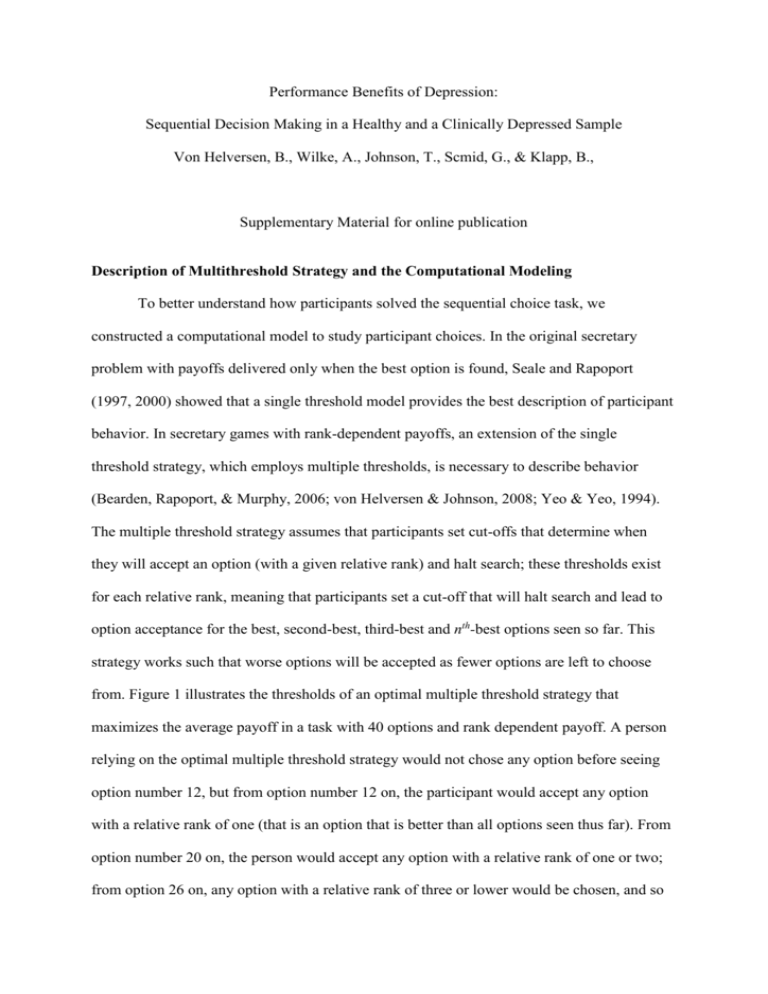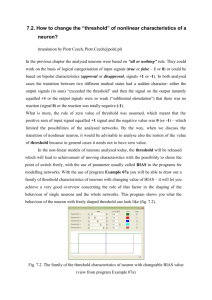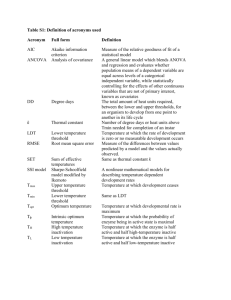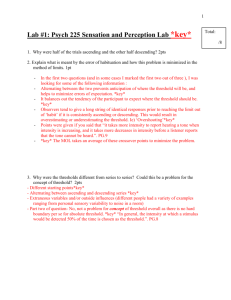ABN-AB2-vonHelversen20100263
advertisement

Performance Benefits of Depression: Sequential Decision Making in a Healthy and a Clinically Depressed Sample Von Helversen, B., Wilke, A., Johnson, T., Scmid, G., & Klapp, B., Supplementary Material for online publication Description of Multithreshold Strategy and the Computational Modeling To better understand how participants solved the sequential choice task, we constructed a computational model to study participant choices. In the original secretary problem with payoffs delivered only when the best option is found, Seale and Rapoport (1997, 2000) showed that a single threshold model provides the best description of participant behavior. In secretary games with rank-dependent payoffs, an extension of the single threshold strategy, which employs multiple thresholds, is necessary to describe behavior (Bearden, Rapoport, & Murphy, 2006; von Helversen & Johnson, 2008; Yeo & Yeo, 1994). The multiple threshold strategy assumes that participants set cut-offs that determine when they will accept an option (with a given relative rank) and halt search; these thresholds exist for each relative rank, meaning that participants set a cut-off that will halt search and lead to option acceptance for the best, second-best, third-best and nth-best options seen so far. This strategy works such that worse options will be accepted as fewer options are left to choose from. Figure 1 illustrates the thresholds of an optimal multiple threshold strategy that maximizes the average payoff in a task with 40 options and rank dependent payoff. A person relying on the optimal multiple threshold strategy would not chose any option before seeing option number 12, but from option number 12 on, the participant would accept any option with a relative rank of one (that is an option that is better than all options seen thus far). From option number 20 on, the person would accept any option with a relative rank of one or two; from option 26 on, any option with a relative rank of three or lower would be chosen, and so Performance Benefits of Depression on. The optimal multiple threshold strategy results in a median performance of 38 points in our task. Maximal relative rank of option 40 35 30 25 20 15 10 5 0 0 10 20 30 40 Number of options seen Figure 1. Shows the maximal relative rank an option may have to be accepted according to the optimal multiple threshold strategy at each point of the game. The multiple threshold strategy describes human behavior well, though participants’ tend to have lower thresholds than the optimal strategy would predict (e.g., Bearden et al., 2006; von Helversen & Johnson, 2008). Here, we assumed that participants’ choices are in line with a multiple threshold strategy, but that the parameter values of the thresholds can differ between participants. We estimated the threshold values which best explained the participants’ choices from the data. However, we only estimated the best fitting values for thresholds for relative ranks of five or lower. We did not try to estimate further thresholds, 2 Performance Benefits of Depression because in our task the majority of the choices (85%) fell on an option with a relative rank of five or lower, and only about 1% of choices fell on options with a relative rank of six or seven. Thus, there was not enough data to obtain stable estimates for parameter values for thresholds for a relative rank of six or higher. We found the best fitting threshold values for each participant by implementing a grid search in Matlab; that is we calculated for each participant the number of choices that was predicted by any possible combination of threshold values, with each threshold taking value between 0 and 40 (for more information on fitting methods see for example Lewandowsky & Farell, 2010). We chose the threshold values that maximized the number of choices predicted by the strategy. On average the multiple threshold strategy with the estimated threshold values could explain 65% (SD = 17.21) of participants’ choices and 76% (SD = 18.89) of choices of options with a relative rank of five or lower. Average parameter values can be found in Table 1. Table 1. Average threshold values and model fit per Group Healthy Recovered Depressed (N = 27) (N = 12) (N = 15) M SD M SD M SD Threshold 1 8.08 4.74 7.92 4.70 12.27 5.66 Threshold 2 11.30 5.60 11.00 6.19 15.87 5.79 Threshold 3 15.59 7.42 14.42 8.40 19.53 5.26 Threshold 4 16.74 7.50 15.42 8.40 20.53 5.26 Threshold 5 18.26 8.05 16.50 8.28 22.20 5.49 Fit 62.22 16.38 63.89 19.27 71.78 16.32 References 3 Performance Benefits of Depression Bearden, J. N., Rapoport, A., & Murphy, R. O. (2006). Sequential observation and selection with rank-dependent payoffs: An experimental study. Management Science, 52, 1437– 1449. Lewandowsky, S. , & Farell, S. (2010). Computational Modeling in Cognition: Principles and Practice. London: Sage Publications. Seale, D. A., & Rapoport, A. (1997). Sequential decision making with relative ranks: An experimental investigation of the secretary problem. Organizational Behavior & Human Decision Processes, 69, 221–236. Seale, D. A., & Rapoport, A. (2000). Optimal stopping behavior with relative ranks: The secretary problem with unknown population size. Journal of Behavioral Decision Making, 13, 280–300. von Helversen, B., & Johnson, T. P. (2008). Der Einfluss von "Satisficing" und "Maximizing" auf das Entscheidungsverhalten [The influence of „Satisficing“ and „Maximizing“ on decision-making]. In W. Sarges & D. Scheffer. Innovative Ansätze für die Eignungsdiagnostik. Reihe: Psychologie für das Personalmanagement (pp. 265–273). Göttingen: Hogrefe. Yeo, A. J., & Yeo, G. F. (1994). Selecting satisfactory secretaries. Australian Journal of Statistics, 36, 185–198. 4



